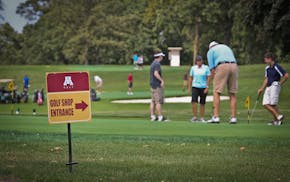Andrea Grazzini and Betsy Sturm approached the thicket of trees, their boots squelching over melting snow. Through the woods and down a steep and eroding slope, the surface of Alimagnet Lake shone an obsidian hue.
The wishbone-shaped body of water straddles the border of Burnsville and Apple Valley. It's the focal point of their Burnsville neighborhood, where bumper stickers on parked cars proclaim residents' commitment to protecting the environment. That's why Grazzini and Sturm fiercely oppose a city plan to pave over part of Alimagnet Park with eight pickleball courts — a design they say will displace animals and propel runoff into the fragile lake below.
"We want it to be preserved for our children's future," Sturm said on a foggy morning at the park.
Their concerns have mounted since October, when officials resumed plans to build a $990,000 complex with 18 parking spaces at the park in southeast Burnsville.
Pickleball players rejoiced when the city authorized the project in October 2022. But work on a comprehensive parks plan brought it to a temporary halt. In the two years since, public and private pickleball courts have cropped up across south and north suburbs. Yet only one facility — six dedicated and two painted courts at Red Oak Park — serves Burnsville residents, even as the sport has skyrocketed in popularity from a retiree pastime to an all-ages pursuit, pickleball player Kraig Kutz said.
"The sport continues to grow, but the availability of courts seems to be just lagging behind the increase in demand," said Kutz, who teaches pickleball in Burnsville. "It's one of those things where, if you build it, people come and play," he added, noting that while several combined pickleball-tennis courts dot the city, some seasoned players dislike those facilities.
Grazzini, who's leading a group called Alimagnet Eco Advocates that opposes the project's location, said she doesn't want to "demonize" pickleball. The activity has divided neighborhoods nationwide, with opponents most often complaining about noise. And while Grazzini and Sturm noted the pop of balls could carry across the roughly 100-acre lake, they said their concerns revolve around natural resources.
The city, they argue, has fallen short of its promises to repair the lake's compromised waters. That makes the nearby park a poor choice for a project they contend will mar the aquatic environment, uproot plants and harm animals. Grazzini summed up their stance like this:
"Can we restore the lake first before we add more problems to it?"
Water quality at Alimagnet Lake
The neighbors say the lake's issues are in plain sight: Greasy algae rippling across its surface. Clumps of invasive pondweed lodging in boat motors. Persistent flooding submerging docks.
Environmental issues landed Alimagnet Lake on the Minnesota Pollution Control Agency's impaired waters list in 2002. That pushed Burnsville officials, often in partnership with Apple Valley and the Vermillion River Watershed Joint Powers Organization, to pursue a slate of restoration projects.
They stocked the body of water with thousands of catfish and bass. They installed iron-enhanced sand filters in stormwater ponds to reduce the flow of phosphorus into the lake. They initiated alum treatments to slash the phosphorus that's accumulated following decades of runoff.
But problems remain. The Metropolitan Council in 2022 gave the lake a 'D' grade in water quality. Preceding the bad mark was a survey showing largemouth bass have recently remained sparse. And Alimagnet Lake's average daily phosphorus loads have exceeded the maximum amount approved by the Environmental Protection Agency in recent years.
Those figures illustrate why additional impervious surfaces don't belong at Alimagnet Park, opponents of the pickleball project say. Burnsville City Council Member Dan Gustafson called their argument that the city hasn't done enough to restore the lake a "point well made."
"I need to find out a little bit more about what we have done out there," he said. "We take it very seriously here in the city of Burnsville, our water quality."
Other sites for pickleball in Burnsville
A city spokesperson said Parks and Recreation Director Garrett Beck wasn't available for an interview this week. But in an email Grazzini shared with the Minnesota Star Tribune, Beck explained the city's rationale for placing the courts at Alimagnet Park.
The area, he wrote, is a well-used green space in a portion of Burnsville absent dedicated pickleball courts. It boasts lighting that illuminates a baseball diamond elsewhere in the park, and the cluster of pickleball courts would stand 500 feet from the nearest home, Beck added.
As for the environmental concerns, Beck said staff members are working with a consultant to develop design options that minimize impervious surfaces. City spokesperson Paul Omodt pointed to other potential mitigation measures, including installing fencing to reduce runoff. And at an October meeting, Mayor Elizabeth Kautz asked Beck about plans for a holding pond — a receptacle that isolates and treats contaminated water before it flows into the lake.
Beck wrote in the email that the city is committed to lifting the water source off the impaired waters list, pointing to the sand filter and alum treatments. "But it does take time," he wrote. Omodt said an October reading showed the lake was "close" to meeting state standards for phosphorus levels, with future alum treatments likely to improve water quality.
Yet Grazzini and Sturm contend these efforts won't adequately protect the lake from the pickleball project. Their goal: persuade officials to relocate the courts. One idea is to retrofit a hockey rink with courts in the summer, which would also eliminate the need for new lighting. But Beck said in the email that Burnsville lacks rinks that could accommodate large groups of players, adding that the freezing and thawing of ice can crack playing surfaces and increase maintenance costs.
Kutz, the pickleball player, said Alimagnet Park's proposed design of eight clustered courts makes it an excellent site for tournaments. "That's one of the endearing things about it: getting to play with other people," he said.
City Council Member Cara Schulz said she's not tethered to a specific location, so long as the city follows through on its promise to build more courts. The Alimagnet location, she added, has the benefit of being a "fairly developed park," though she questioned if adding more parking was necessary.
More details about the project's design will emerge before City Council votes on it in April. That gives its opponents four more months to fight back against the current location, while its supporters wait with anticipation for more space to play.
Supreme Court allows DOGE team to access Social Security systems with data on millions of Americans

Thompson found guilty of murder in car crash that killed 5 young women

University of Minnesota is putting its golf course up for sale
Feeding Our Future probe: Apple Valley woman charged with defrauding food program of $1.4 million

